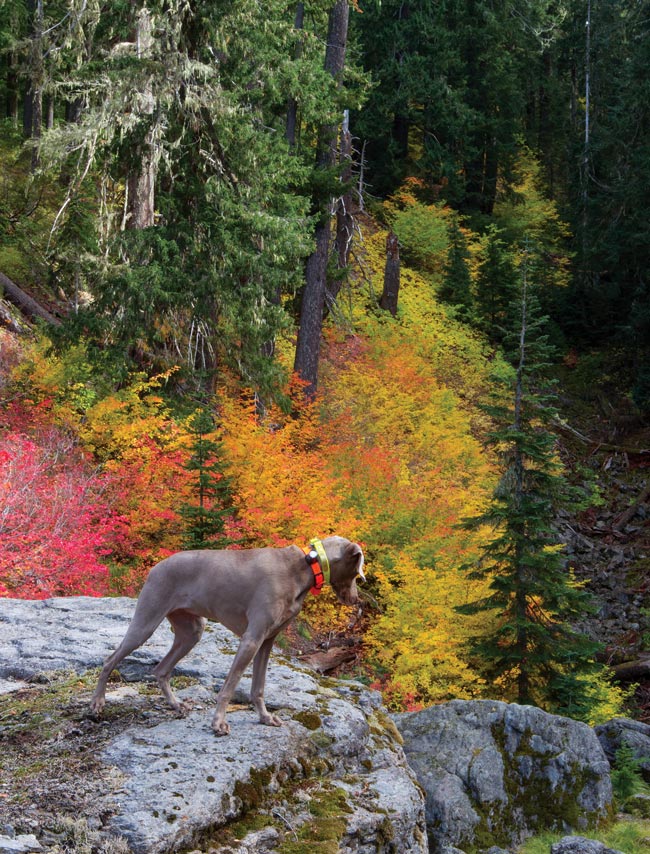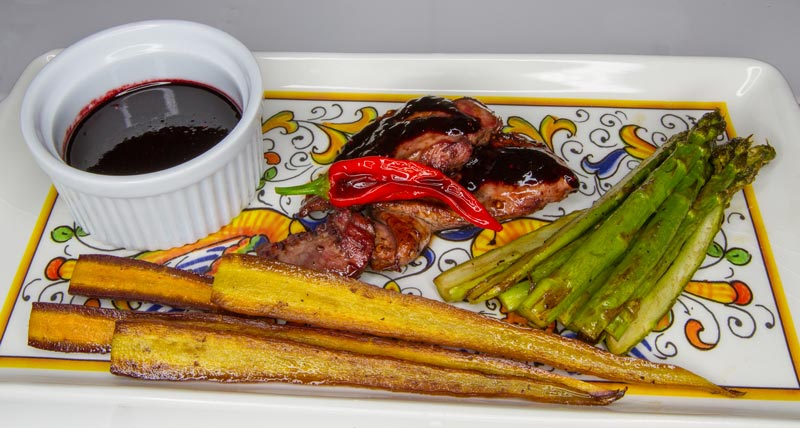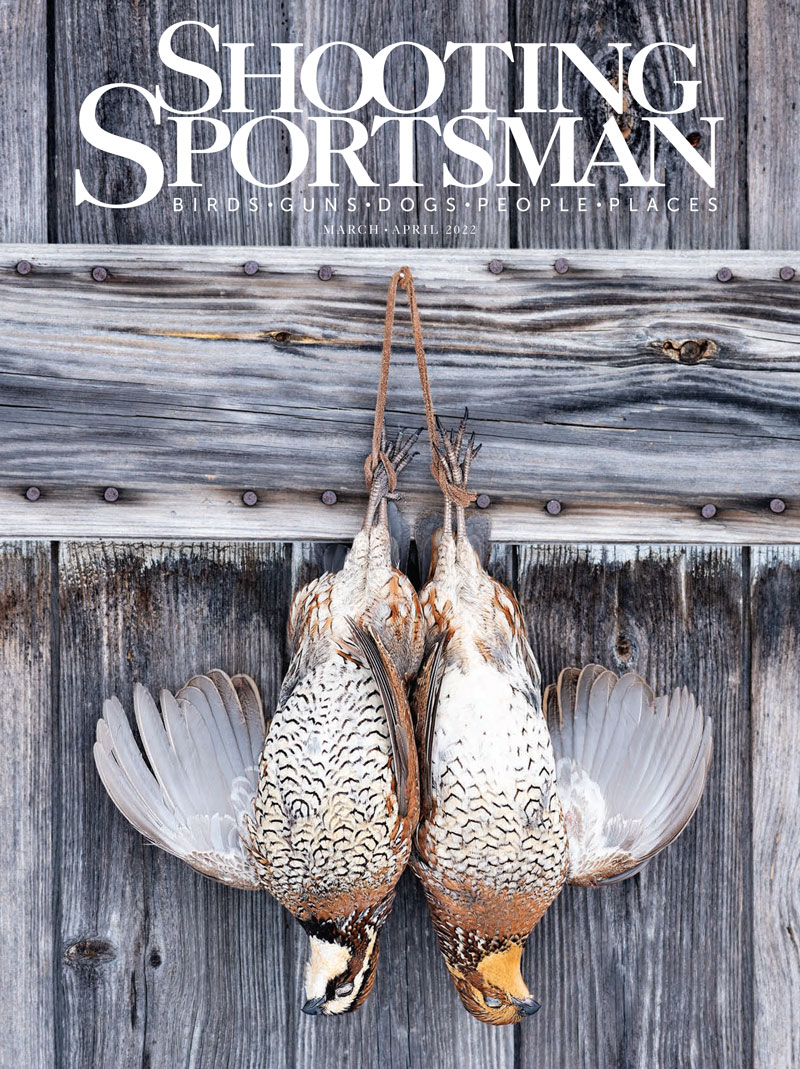Sooty grouse in Oregon’s Cascades
Text and photos by John Shewey
After the first agonizingly slow mile,
I realized the flaw in my plan: Topo maps don’t show blowdowns, and the canyon bottom was littered with fallen timber.
The second mile was exhausting but, younger and stronger back then and probably more stubborn, I reached my destination: a remote mountain lake that fulfilled my hopes for deep-bodied trout. No trails penetrated the spacious cirque high in Oregon’s Cascade Range; subalpine wilderness stretched for miles. The next morning, after a night spent under a moon so bright that I could peruse my map for an escape route, I opted to climb up and over a steep, timbered ridge and descend to a main trail rather than retrace my ill-advised route through the blowdown jungle.
And that’s how I discovered the blue grouse of Saddleback Ridge. The ridgeline connects two modest summits more than a mile apart, and much of the terrain atop the scarp is level and parklike, easy to walk. Thereon I discovered stately old-growth firs shading a low understory rich in huckleberries and mountain raspberries, with bracken ferns and bear grass thriving in small sunlit glades. I walked up on a mother blue grouse with half-grown chicks. I gave her a wide berth, picked my way down the opposite slope, intersected the trail and walked an easy four miles out of the wilderness.


A month later I retraced those four miles with young Jake, my first Weimaraner, and climbed back up Saddleback Ridge. We walked the length of it and harvested three sooty grouse—called blue grouse in those days when they were conspecific with the dusky grouse of the Rockies. A year later we repeated our success, and then made a second trek to explore the ridgeline on the opposite side of the cirque. It, too, held grouse within untrammeled forest. Discovering these new grouse coverts within the Mount Jefferson Wilderness Area reinvigorated me.
Oregon’s human population was burgeoning at the time, and the simple archaic joy of walking old gravel forest roads behind a tail-wagging bird dog—the way I learned to hunt grouse with Dad—was eroding in the face of too many hunters who don’t deserve the “wingshooter” epithet. They drive the roads looking for grouse and shoot birds off the gravel, not even allowing them the dignity of flight. Then came the explosive popularity of archery. Too many people driving forest roads had robbed me of a cherished pastime. I had quit hunting blue grouse.
But no roads penetrate designated wilderness, and for the better part of a decade I returned each season to these precipitous ridges beyond the reach of the lazy and unsporting. Often I shot grouse, sometimes not; but always I enjoyed the adventure, and I began to revel in my familiarity with the ridgetops and the breathtaking views of snowcapped volcanic peaks.
And then it all went up in flames. In 2003, less than a month before the grouse opener, the B&B Complex fire erupted atop the Cascades, charring 90,769 acres—including more than 40,000 acres within the Mount Jefferson Wilderness. Saddleback Ridge and everything around it was scorched. I was crestfallen. Again I gave up grouse hunting, which had for many years occupied my Septembers until chukar season opened in October.
But that verdant high forest is a temptress; her siren played upon my soul. Beckoned by the allure of autumn’s misty mornings and conflagrant vine-maple leaves, I returned to the mountains, hiked unfamiliar terrain until it became familiar, and harvested sooty grouse over Java, the fourth and best of my Weims.
During these rejuvenating grouse seasons, I explored new coverts, wearing out boot leather and trusting what I’d learned about these birds many years prior: Sooty grouse live in mature coniferous forests, but they like openings in the form of natural glades, hanging valleys, aging clearcut edges, timberline meadows and sunlit tentacles of old forest fires that reach into stands of Douglas fir, true fir and hemlock. The birds like steep slopes, but hens with broods often forage on lesser inclines, even level expanses if they have sufficient escape cover. Multiyear males often occupy old-growth forests on steep, deeply shaded north slopes, especially those with swales and open ridgetops. Sooty grouse thrive on berries and are especially fond of blue huckleberries, which are prolific in the high Cascades. Those berries lend the birds’ medium-dark meat a delicate flavor with a touch of sweetness and not a hint of gaminess. As their diets shift away from berries in October and early November, that faint sweet flavor dissipates; but they remain exceptionally fine fare through autumn.
Sooty grouse prefer diverse but not tall or necessarily dense understory. Should you find yourself fighting through stands of rhododendron, you won’t find grouse. But if underfoot amid the firs you find bracken fern, huckleberries, a few tufts of bear grass, wild buckwheat, mountain willows and hawkweed or other daisylike flowers, keep a sharp eye on your dog’s body language and be ready to snap those shotgun barrels closed. Like many gamebirds, sooty grouse forage most actively from early to mid-morning and again in late afternoon. In between they seek cover for dust-bathing and loafing.


Two dozen federally designated wilderness areas totaling more than a million roadless acres protect tracts of forest in Oregon’s Cascades (to say nothing of California and Washington). Sooty grouse inhabit appropriate habitat throughout these wilderness areas, which reside within five expansive national forests: Mount Hood, Willamette, Deschutes, Rogue River-Siskiyou and Umpqua. Despite many decades of intense logging along with frequent summer forest fires, some 7 million acres of national forest retain extensive grouse habitat even outside the protective boundaries of the wilderness areas. Forest roads lead to myriad trailheads, some heavily used by hikers, others virtually unknown. Even outside designated wilderness, miles and miles of maintained trails lead into and through excellent grouse habitat. In all these years I’ve yet to encounter a fellow grouse hunter deep in the woods despite the easy access by trail. Perhaps “ready access” is a better descriptor—trails into blue grouse country can be steep.
National forest maps, especially ranger-district maps, detail trails and the roads that lead to trailheads. Ranger-district maps are topographic, allowing you to decipher slope, elevation and exposure. Some wilderness-area maps are also topographic, but once you’ve homed in on a likely area within one of the wilderness areas, get the United States Geological Survey map that covers that location—these high-detail maps are invaluable. Online satellite views provide another excellent tool for locating potential grouse habitat, particularly when used in conjunction with topographic maps. Maps are available from the headquarter and district offices for the various national forests.
The trails provide access to the habitat and often into prime coverts. Many trail segments pass through miles of prime cover—look for those that lead up and onto ridgelines, high saddles, buttes and mountains. In other places trails take you close enough to strike out cross-country up into grouse habitat—the places that provide postcard-pretty views of the lofty peaks for which some of the largest wilderness areas are named: Mount Jefferson, Mount Hood, Three Sisters, Mount Washington, Mount Thielsen. Be careful, however. The Cascade Range conceals its rugged underpinning beneath verdurous camouflage. Hidden cliffs and rockfalls abound on those steep ridges and ramparts where grouse live. Keep your dog close, recall her when you should, leash her if necessary. These mountains are also home to black bears, cougars and coyotes, but all three shun humans and are rarely seen; a beeper collar or loud bell can provide peace of mind nonetheless.
You’ll follow the dog over some rugged terrain, but just as often trails through the forest lead to parklike benches and ridgetops lush with huckleberries and ferns and spirelike firs—places where the dog can range.
But not too far. Sooty grouse can be ill-behaved despite the old “fool-hen” moniker that describes their oft-tame behavior. But a bird dog changes that equation. In the presence of a good staunch pointing dog, sooty grouse often hold tight for the flush. Or they don’t. Sometimes through no fault of the dog, grouse will fly down the mountainside and disappear into dense forest. They also fly up into trees and secret themselves amid the bows. In these cases sometimes you can unnerve them by waiting them out; or you can toss a stone into the tree and perhaps prompt a flush. But be ready to pull a sizeable lead: Sooty grouse launch from trees with remarkable speed, almost always downhill.
Oregon’s grouse season runs from September 1 to January 31. But realistically it lasts until the first snow falls, typically between mid-October and mid-November. Literature routinely suggests sooty grouse migrate altitudinally, moving higher in winter, but I’ve seen no evidence of this in Oregon’s Cascades. The birds do, however, move to large stands of timber, because when snow accumulates, grouse become arboreal—living in trees and feeding on needles. (Birds shot in winter often have a disagreeable resinous flavor, but few sootys are harvested so late, because snow blocks the secondary roads that lead into the forests.) I suppose you could hunt by snowshoe or cross-country skis, but I’m not sure your dog would appreciate you gliding effortlessly across the white landscape while she postholes with every step.

Oregon’s limit is three sooty grouse per day, nine in possession. Some years daily limits will come quickly; other years you’ll walk miles between birds. Populations are cyclical based upon food availability and spring nesting success. Last season was especially dismal in the area I hunt in the Willamette National Forest. The huckleberry crop completely failed following drought and record-setting summer heat. Mountainsides covered in acre upon acre of huckleberry shrubs yielded not a single berry. Grouse were few and far between.
The miles added up for Java and me. We harvested a brace one early-September afternoon when she locked up at a copse of mountain willow and serviceberry. I circled behind her, upslope to gain a bit of level ground for shooting, and then walked in. Two birds flushed, and I dropped one. Then three more flushed in succession like popcorn in a popper. The first made an easy mark, and I watched the others fly out of sight while I grappled with a pang of guilt for paring numbers from a hen-and-brood covey in such a lean year. During the next two weeks a few more hens and young-of-the-year fell, thanks to Java’s unerring nose. But guilt laden, I decided to hunt the unicorn: I would shoot only a multiyear male grouse. If we could find one. Adult males are massive, nearly the size of pheasants, and overall dark gray, as opposed to hens and young birds, which are patterned in rich mottled brown and gray tones.
A big male grouse erupted downhill and banked to the right.
I have hunted sooty grouse for a long time as well as dusky grouse in the Rockies and in eastern Oregon’s Blue Mountains. Sooty grouse range from California to Alaska but are limited to the coastal ranges and the Cascades; only in the northern half of their range, from northernmost Washington to Alaska, do sootys and duskys share a narrow band of range. Empirically, good dusky grouse habitat holds more grouse per hectare than does good sooty grouse habitat, and last season was the leanest I’ve ever witnessed for sootys. Multiyear males are positively rare under such conditions. For Java and me, the miles accumulated—wonderful, fir-scented, solitudinous miles along little-used trails vacant of even the intrepid hikers, thanks to the encroachment of autumn proper. Fall colors intensified; snow dusted the volcanoes; we were treated to mesmerizing views from atop the ridges and crags.
I passed up shots at a few hens and young birds (much to Java’s dismay), harvested a few edible mushrooms, marveled at a fearless pileated woodpecker I met face to face, walked in the shadows of 500-year-old Doug firs and nearly stumbled into a herd of elk. Onward we hiked—two, sometimes three days each week—into mid-October, amassing probably 60 trail miles and at least a half dozen off trail.

On the last day a steely fog clung stubbornly to the highlands as we hiked up a trail that hadn’t seen a boot print since August. Halfway up a precipitous butte, the switch-backing path emerged from the leaden gloom into clear blue skies. Deep-green firs accented acres of orange-painted huckleberry shrubs, and high up on the ridgeline spritely fresh snow gleamed in the morning sun. Java tested the air, nose held high, and then turned and coursed downslope. Her tail told the story—hyper-speed windshield-wiper mode meant she had scented grouse. She wedged her way through a sweep of willows, and then disappeared behind a grove of firs. Her beeping locator collar switched to the steady point-mode cadence.
Easing down the steep slope, I found Java staunchly on point amid yellowing ferns. I took a few more steps and clicked the barrels closed, and as I did a big male grouse erupted downhill and banked to the right. I can still see his slaty, foot-wide tail, each feather tipped in light dun. The bird I had sought for weeks. I thumbed the safety, drew a lead . . . and then pulled up, pointing the barrels harmlessly skyward, and watched him sail away, magnificently, far down the slope, hoping he would sire many young after winter eased its grip on the high Cascades.
Sooty Grouse with Soy-Huckleberry Sauce

Sooty grouse have such a wonderful, delicate flavor that you can’t go wrong with a simple camp meal: Salt and pepper the filets and cook them briefly in a well-oiled skillet. But for a more epicurean experience, take advantage of the Oregon Cascades’ berry bounty. During the prime part of the grouse season, from September through October, sootys feed heavily on berries, especially huckleberries, along with a wide variety of greens, flowers and seeds (and some insects). Their meat tends toward a medium-dark color (lighter in young birds) but has no gaminess whatsoever. They are delicious. Filet the breast meat off the bone and pound the filets with a clam hammer or rolling pin to tenderize them. Above all, don’t overcook them. As with most gamebirds, the filets should be removed from the heat while the centers are still rare (they’ll cook to pink while resting off the heat).
This recipe for grouse with soy-huckleberry sauce lets the grouse meat remain the star, and you can harvest huckleberries during a September grouse hunt or buy them frozen at fine grocers.
Ingredients
Grouse breast filets
2 cups huckleberries, puréed
¼ cup brown sugar
¼ cup soy sauce
2 tablespoons hoisin sauce
Juice from 2 limes
¼ stick unsalted butter
Preparation
- Purée the huckleberries (add a bit of water to thin the purée).
- Whisk the purée with the brown sugar, soy sauce, hoisin sauce and lime juice. Pour half the mix into a small Ziplock bag with the grouse breasts and marinate for three hours in the refrigerator.
- When marinating is complete, melt the butter in a small saucepan, stir in the reserved soy-berry sauce and blend thoroughly over medium heat. Increase heat until the sauce begins to boil, then reduce to a simmer, stirring often, until the sauce thickens. Set aside.
- Remove the grouse filets from the marinade and place them on a preheated and well-oiled cast iron pan over medium-high heat. Cook each side for 1 to 2 minutes, so the centers of the filets remain rare. Plate the filets and drizzle with the sauce. Serve with grilled vegetables, sautéed chanterelles if you’re lucky enough to find some and a side of the sauce. —J.S.
An avid upland hunter from Oregon, John Shewey is a freelance writer and photographer and the Editor-in-Chief of American Fly Fishing Magazine.




